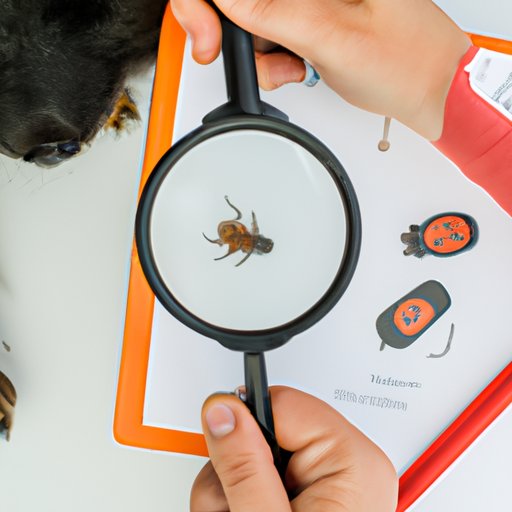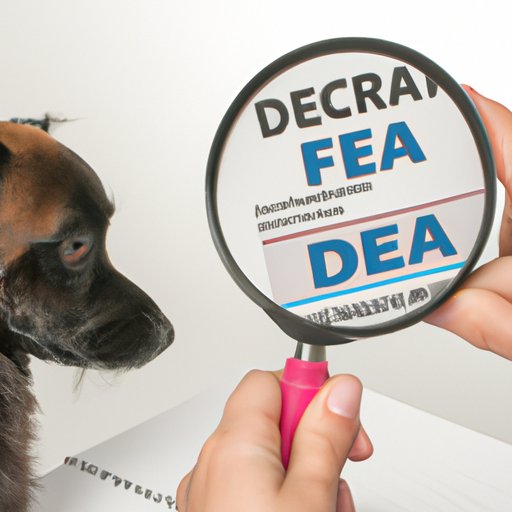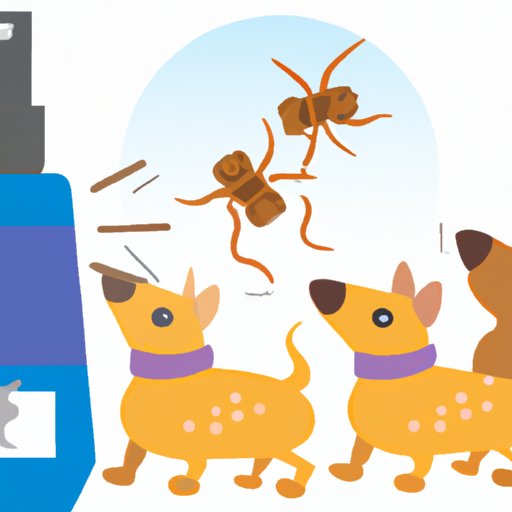Introduction
Fleas are small, wingless bugs known for their ability to jump long distances and feed off the blood of mammals and birds. Dogs are particularly vulnerable to flea infestations due to their fur coats and outdoor activities. In this article, we will explore the life cycle of fleas, the different types found on dogs, how they’re transmitted, how to diagnose and treat an infestation, and ways to prevent future outbreaks.
Exploring the Life Cycle of Fleas on Dogs
The life cycle of a flea is complex and consists of four distinct stages: egg, larvae, pupae, and adult. The total cycle can take anywhere from two weeks to eight months depending on environmental factors such as temperature and humidity.
Egg Stage – Female fleas will lay eggs after feeding on a host animal’s blood. These eggs are white or yellowish in color and measure around 0.5mm in length. They are oval-shaped and sticky, allowing them to adhere to the fur of a dog or other mammal. It takes approximately two days for the eggs to hatch.
Larvae Stage – After hatching, the larvae will feed on organic debris and flea feces. This stage lasts anywhere from five to eleven days, and the larvae will molt twice before becoming pupae.
Pupae Stage – Once the larvae have reached the pupae stage, they will form cocoons and remain dormant until disturbed by vibrations, heat, or light. This stage usually lasts about one week, though it can take up to several months depending on environmental conditions.
Adult Stage – The adult flea will emerge from its cocoon once it senses a potential host. This stage is the most dangerous as the flea will immediately begin to feed and reproduce. Adult fleas can live for up to three months, during which time they can lay hundreds of eggs.

Examining the Different Types of Fleas Found on Dogs
There are several different species of fleas that can infest dogs. The most common are cat fleas, dog fleas, human fleas, and other flea species. Each species has different characteristics and behaviors, so it’s important to identify the type of flea in order to properly treat the infestation.
Cat Fleas – Cat fleas are the most common type of flea found on dogs. They are typically dark brown in color and range from 2-4mm in length. These fleas are drawn to cats and dogs, and can be found in both indoor and outdoor environments.
Dog Fleas – Dog fleas are similar in size and color to cat fleas, but they prefer to feed on dogs rather than cats. These fleas are more common in areas where there are large populations of stray or wild dogs.
Human Fleas – Human fleas are larger than cat and dog fleas, measuring up to 6mm in length. They are typically reddish-brown in color and prefer to feed on humans. These fleas are less common than the other species and are usually found in areas with poor sanitation.
Other Flea Species – There are several other species of fleas that can infest dogs, including deer, sand, and rat fleas. Each species has its own unique characteristics and behaviors, so it’s important to identify the type of flea in order to properly treat the infestation.
Investigating How Fleas are Transmitted to Dogs
Fleas can be transmitted to dogs in a variety of ways. The most common methods of transmission include direct contact, indirect contact, and environmental exposure.
Direct Contact – Direct contact is the most common way for fleas to be transmitted to a dog. This occurs when a dog comes into contact with another animal that is already infested with fleas. This could be through petting, playing, or sleeping in close proximity to the infested animal.
Indirect Contact – Indirect contact occurs when a dog comes into contact with an object that has been contaminated with fleas. This could be a bedding item, a piece of furniture, or even another person’s clothing. Fleas can survive on these objects for up to two weeks, so it’s important to clean and disinfect any items that may have come into contact with a flea-infested animal.
Environment – Fleas can also be transmitted to a dog through its environment. Flea eggs and larvae can survive in the soil, grass, and other areas where animals have previously been. This means that a dog can become infested simply by walking through an area that has been contaminated with fleas.

Analyzing How to Diagnose and Treat Fleas on Dogs
Diagnosing a flea infestation on a dog can be difficult as the signs can be subtle. The most common signs of flea infestation include excessive scratching, hair loss, redness, and bumps or scabs on the skin. If you suspect your dog has fleas, it’s important to visit a veterinarian for a proper diagnosis and treatment plan.
Once a flea infestation has been diagnosed, the vet will recommend a course of treatment based on the severity of the infestation. Treatment options include flea baths, topical treatments, oral medications, and injections. It’s important to follow the vet’s instructions and continue the treatment until the infestation has been eliminated.
Discussing Ways to Prevent Fleas on Dogs
The best way to protect your dog from fleas is to take preventive measures. This includes proper grooming, regular vaccinations, keeping living areas clean, and using topical products such as flea collars or sprays. It’s also important to regularly check your dog for fleas and to immediately address any signs of infestation.
Proper Grooming – Regularly brushing and combing your dog’s coat can help to remove fleas and their eggs. It’s also important to bathe your dog regularly and use a flea shampoo if necessary.
Regular Vaccinations – Keeping your dog up to date on its vaccinations can help to reduce the risk of flea infestation. Vaccines for fleas and ticks are available and should be administered according to your vet’s recommendations.
Clean Living Areas – Regularly cleaning and vacuuming your home can help to reduce the number of fleas in the environment. Be sure to wash all bedding and vacuum carpets and furniture regularly.
Use of Topical Products – Using topical products such as flea collars, sprays, and powders can help to repel fleas and reduce the risk of infestation. These products should be used according to the manufacturer’s instructions.

Evaluating Common Home Remedies for Flea Infestations on Dogs
In addition to professional treatments, there are several home remedies that can be used to treat flea infestations on dogs. These include vacuuming, sprinkling salt, applying apple cider vinegar, and using baking soda.
Vacuuming – Vacuuming can help to remove fleas and their eggs from carpets and furniture. Be sure to discard the vacuum bag after each use to prevent the fleas from spreading.
Sprinkling Salt – Sprinkling salt on carpets and furniture can help to kill fleas and their eggs. The salt should be left in place for several hours before being vacuumed up.
Apple Cider Vinegar – Apple cider vinegar can be used as a natural flea repellent. It can be applied directly to the fur or added to a spray bottle for easy application. However, it’s important to dilute the vinegar before use to avoid skin irritation.
Baking Soda – Baking soda can be used to kill fleas and their eggs. It should be sprinkled liberally on carpets and furniture and left in place for several hours before being vacuumed up.
Conclusion
Fleas are a common problem for dogs and can cause discomfort and health issues if left untreated. By understanding the life cycle of fleas, the different types found on dogs, how they’re transmitted, how to diagnose and treat an infestation, and ways to prevent future outbreaks, owners can better protect their pets. Remember to consult a veterinarian if you suspect your dog has fleas and to take preventive measures to reduce the risk of infestation.
(Note: Is this article not meeting your expectations? Do you have knowledge or insights to share? Unlock new opportunities and expand your reach by joining our authors team. Click Registration to join us and share your expertise with our readers.)
